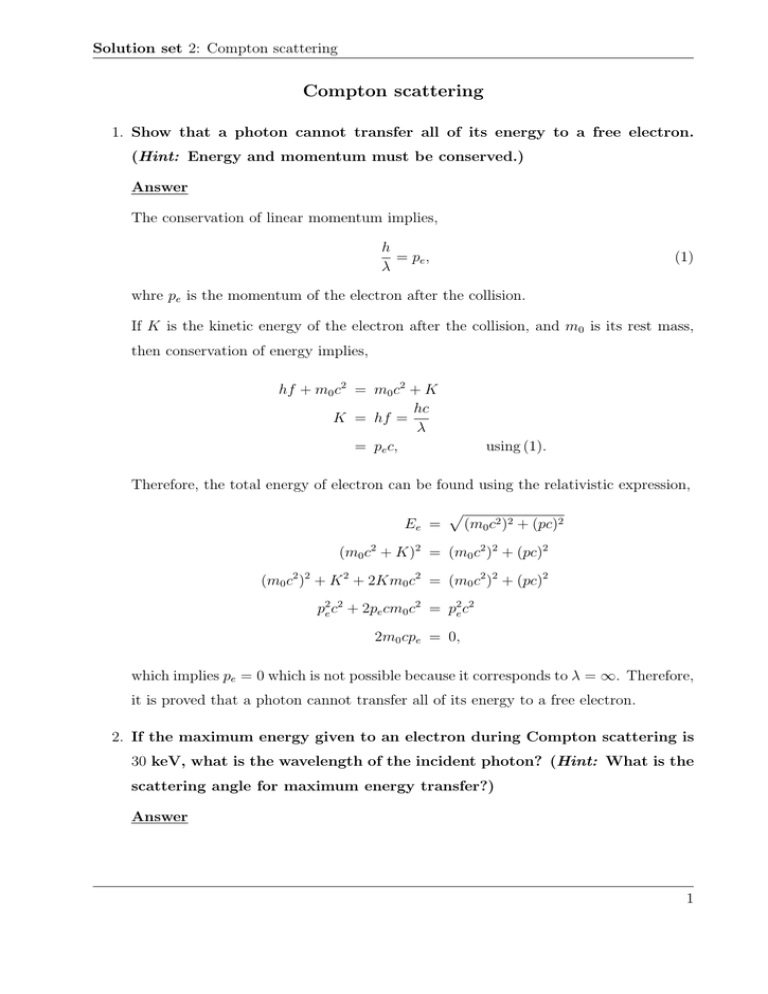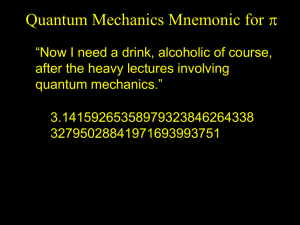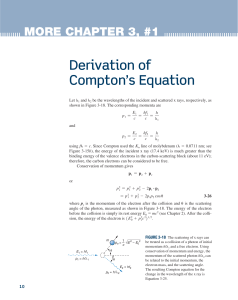Compton scattering
advertisement

Solution set 2: Compton scattering Compton scattering 1. Show that a photon cannot transfer all of its energy to a free electron. (Hint: Energy and momentum must be conserved.) Answer The conservation of linear momentum implies, h = pe , λ (1) whre pe is the momentum of the electron after the collision. If K is the kinetic energy of the electron after the collision, and m0 is its rest mass, then conservation of energy implies, hf + m0 c2 = m0 c2 + K hc K = hf = λ = pe c, using (1). Therefore, the total energy of electron can be found using the relativistic expression, Ee = √ (m0 c2 )2 + (pc)2 (m0 c2 + K)2 = (m0 c2 )2 + (pc)2 (m0 c2 )2 + K 2 + 2Km0 c2 = (m0 c2 )2 + (pc)2 p2e c2 + 2pe cm0 c2 = p2e c2 2m0 cpe = 0, which implies pe = 0 which is not possible because it corresponds to λ = ∞. Therefore, it is proved that a photon cannot transfer all of its energy to a free electron. 2. If the maximum energy given to an electron during Compton scattering is 30 keV, what is the wavelength of the incident photon? (Hint: What is the scattering angle for maximum energy transfer?) Answer 1 Solution set 2: Compton scattering For maximum energy transfer to an electron, the Compton shift in wavelength is, ∆λ = λ′ − λ = λc (1 − cos 180) 2h ∆λ = λ′ − λ = m0 c 2h λ′ = λ + 2 , m0 c Now, Using the conservation of energy, E − E′ hc hc − ′ λ λ hc(λ′ − λ) ′ ( λλ) 2h 1 hc m0 c K 2h2 m0 K 2h2 m0 K 2h2 2h λ− λ2 + m0 c m0 K 2 −12 λ + (4.85 × 10 )λ − (2 × 10−22 ) = K = K = K = λλ′ 2h ) m0 c 2h = λ2 + λ m0 c = λ(λ + = 0 = 0. A meaningful solution of this equation is, √ −b ± b2 − 4ac λ = 2a √ −(4.85 × 10−12 ) ± (4.85 × 10−12 )2 − 4(−2 × 10−22 ) = 2 = 11.8 pm. 3. In a Compton collision with an electron, a photon of violet light (λ = 4000 Å) is backscattered through an angle of 180◦ . (a) How much energy (eV) is transferred to the electron in this collision? (b) Compare your result with the energy this electron would acquire in a photoelectric process with the same photon. (c) Could violet light eject electrons from a metal by Compton collision? Explain. Answer 2 Solution set 2: Compton scattering The Compton shift in wavelength for a backscattered photon is, ∆λ = λc (1 − cos 180) = λc (2) = 4.86 × 10−12 pm. The kinetic energy gained by an electron is given by, (one can derive this expression) ∆λ λ + ∆λ (1243 eV nm) (4.86 × 10−12 pm) = (400 × 10−9 m)(4.86 × 10−12 pm + 400 × 10−9 m) = 3.7 × 10−5 eV. K = hf (b) If the violet photon transfers all of its energy to the electron, it will acquire an energy given by, hc λ 1243 eV nm = 400 nm = 3.1 eV, E = which is very large as compared to the energy acquired in the Compton effect. Photoelectric effect may or may not take place depending on the metal’s work function. (c) Violet light cannot eject electrons from a metal surface due to Compton effect because the energy transferred by the X-ray photons (3.7 × 10−5 eV) is much smaller than typical work functions. 4. An electron initially at rest recoils from a head-on collision with a photon. Show that the kinetic energy acquired by the electron is 2hf α/(1 + 2α), where α is the ratio of the photon’s initial energy to the rest energy of the electron. 3 Solution set 2: Compton scattering Answer ∆λ λ + ∆λ 2h 2h hf , using ∆λ = · 2h m0 c m0 c(λ + m0 c ) 2h hf ( λm c+2h ) m0 c m0 0 c 2hf hf ( ) 2hf mo c λf + m 0c 2hf hf ) ( m0 c2 1 + m2hf 2 0c 2hf α hf , where α = , 1 + 2α m0 c2 K = hf = = = = = which is the required result. 5. Derive the relation θ cot = 2 ( hf 1+ m0 c2 ) tan ϕ, (2) between the direction of motion of the scattered photon and the recoil electron in the Compton effect. Answer hc = momentum of incident photon. λ hc p1 = ′ = momentum of scattering photon an angle θ. λ p2 = momentum of scattered electron at an angle ϕ. p = 4 Solution set 2: Compton scattering Using the laws of conservation of momentum, we have, p = p1 cos θ + p2 cos ϕ p2 cos ϕ = p − p1 cos θ p2 sin ϕ = p1 sin θ Taking the ratio, p2 sin ϕ = p2 cos ϕ tan ϕ = = = = = = ( ) hf tan ϕ 1 + = mc2 = p1 sin θ − p1 cos θ 1 hf − cot θ p1 c sin θ 1 λ′ − cot θ λ sin θ λ sin θ ′ λ − λ cos θ λ sin θ (λ − λ cos θ) + ∆λ λ sin θ h λ(1 − cos θ) + mc (1 − cos θ) sin θ hf (1 − cos θ) + mc 2 (1 − cos θ) sin θ 1 − cos θ 2 sin 2θ cos 2θ 1 − cos2 2θ + sin2 2θ hf c 2 sin 2θ cos 2θ 2 sin2 2θ θ = cot · 2 = 6. (a) In considering the Compton effect, how would you compare the scattering of photons from bound and free electrons? (b) An X-ray photon has sufficient energy to overcome the work function. What determines whether the photoelectric or Compton effect takes place? Answer (a) In the Compton effect, if the electron is bound to an atom, the atom as a whole will recoil, carrying away most of the energy in the collision. This means the change in wavelength (and energy) of the scattered electron is smaller, may be even indetectable. This is shown by ∆λ = h (1 − cos θ) Mc which decreases as M goes up. For 5 Solution set 2: Compton scattering a free electron, M = mass of an electron, giving ∆λ very large. So, Compton effect is likely to be easily observable for free electron. (b) If the electron is free, both the Compton effect and photoelectric effect are equally likely to occur. If the electron is bound, even then both the processes are likely, but Compton scattering will become less noticeable. 7. (a) Estimate the number density of blackbody photons in a blacked-out room at 20◦ C and compare with the number density of air molecules in the room. (b) The result of (a) gives the impression that matter is a more important constituent of the universe than radiation. Show this is false by comparing the number density of photons in the cosmic ray background radiation (which is an almost perfect blackbody at 2.7 K) with the mean number density of atoms. The mean universal mass density of matter is about 10−26 kg/m3 . Answer The blackbody energy per unit volume at a given temperature T is given by, ∫ ∞ E = ρ(t)df 0 ) ∫ ∞( 8πf 2 hf = df c3 exp( khfT ) − 1 f =0 B ) ∫ ∞( 8πh f3 df = 3 hf c f =0 exp( k T ) − 1 B 4 4 4 8πh kB π T 3 c 15h4 4 0.53 π 5 kB T 4, = c3 h3 = in units of J/m3 . Note that this expression is identical to Stefan-Boltzman law. We integrate over frequency because the expression E takes into account all frequencies up to infinity. 6 Solution set 2: Compton scattering Similarly, the average energy of a single photon is given by Plank’s formula, ∫ ∞ hf hf uavg = d( ) kB T f =0 (exp(hf /kB T ) − 1) 2 2 2 h kB π T = kB T 6h = 2.7kB T. Therefore, the number density of blackbody photons in a room can be estimated as, R uavg 4 4 T 0.53 π 5 kB 1 = 3 3 ch 2.7kB T 3 2 2 0.19 π kB T = c3 h2 = 4.8 × 1014 m−3 . nphotons = To calculate number density of air molecules, we use ideal gas equation as follows, P V = nRT, where n is the number of moles and V is the volume of the gas. Therefore, P = n = V No. density of air molecules = = = n RT V P RT NA P RT 6.02 × 1023 mole × 1.01 × 105 Pa 8.314 J K−1 mole−1 × 298 K 2.5 × 1025 molecules m−3 . (b) For the universe, ( Tuniverse )3 Troom ( )3 2.7 14 3 = (4.8 × 10 m ) 293 nphotons = nroom × = 3.8 × 108 photons/m3 . Sine the universe is mainly hydrogen, using the density of hydrogen ρ = 10−26 kg m−3 and mass of proton mp = 1.67 × 10−27 , we have nmatter = ρ 10−26 kg m−3 = mp 1.67 × 10−27 kg ≈ 6 protons/m3 . 7



